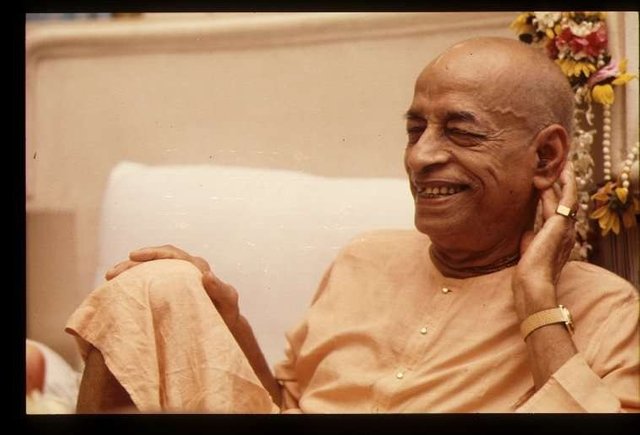BHAGAVAD GITA AS IT IS Complete 18 Chapters - Dramatic Narration With a Photo Visual and Background Music
Although widely published and read by itself, Bhagavad-gita originally appears as an episode in the Mahabhrata, the epic Sanskrit history of the ancient world. The Mahabharata tells of events leading up to the present Age of Kali.
Kali-yuga—the "Age of Quarrel and Hypocrisy " The fourth and last age in the cycle of a maha-yuga. This is the present age in which we are now living. It began 5,000 years ago and lasts for a total of 432,000 years. It is characterized by irreligious practice and stringent material miseries. In the Srimad-Bhagavatam the age is personified as an evil black man who tries to kill a helpless cow and bull. The four legs of the cow represent the four principles of religiosity-namely, truth, cleanliness, mercy and austerity. The bull represents religion itself; The most recommended process of spiritual upliftment in this age is sankirtana, the congregational glorification of the Lord through chanting His holy name i.e. The Hare Krishna Maha Mantra: Hare Krishna Hare Krishna, Krishna Krishna, Hare Hare; Hare Rama Hare Rama, Rama Rama, Hare Hare. See at the end of this description the initiation of this Sankirtana movement.
It was at the beginning of this age, some fifty centuries ago, that Lord Krishna spoke Bhagavad-gita to His friend and devotee Arjuna.
Their discourse—one of the greatest philosophical and religious dialogues known to man—took place just before the onset of war, a great fratricidal conflict between the hundred sons of Dhrtarastra and on the opposing side their cousins the Pandavas, or sons of Pandu.
Dhrtarastra and Pandu were brothers born in the Kuru dynasty, descending from King Bharatad, a former ruler of the earth, from whom the name Mahabharata derives. Because Dhrtarastra, the elder brother, was born blind, the throne that otherwise would have been his was passed down to the younger brother, Pandu.
When Pandu died at an early age, his five children—Yudhisthira, Bhima, Arjuna, Nakula and Sahadeva—came under the care of Dhrtarastra, who in effect became, for the time being, the king. Thus the sons of Dhrtarastra and those of Pandu grew up in the same royal household. Both were trained in the military arts by the expert Drona and counseled by the revered “grandfather” of the clan, Bhisma. Yet the sons of Dhrtarastra, especially the eldest, Duryodhana, hated and envied the Pandavas. And the blind and weak-minded Dhrtarastra wanted his own sons, not those of Pandu, to inherit the kingdom.
Thus Duryodhana, with Dhrtarastra’s consent, plotted to kill the young sons of Pandu, and it was only by the careful protection of their uncle Vidura and their cousin Lord Krishna that the Pandavas escaped the many attempts against their lives.
Now, Lord Krishna was not an ordinary man but the Supreme Godhead Himself, who had descended to earth and was playing the role of a prince in a contemporary dynasty. In this role He was also the nephew of Pandu’s wife Kunti, or Prtha, the mother of the Pandavas. So both as a relative and as the eternal upholder of religion, Krishna favored the righteous sons of Pandu and protected them.
Ultimately, however, the clever Duryodhana challenged the Pandavas to a gambling match. In the course of that fateful tournament, Duryodhana and his brothers took possession of Draupadi, the chaste and devoted wife of the Pandavas, and insultingly tried to strip her naked before the entire assembly of princes and kings. Krishna’s divine intervention saved her, but the gambling, which was rigged, cheated the Pandavas of their kingdom and forced them into thirteen years of exile.
Upon returning from exile, the Pandavas rightfully requested their kingdom from Duryodhana, who bluntly refused to yield it. Duty bound as princes to serve in public administration, the five Pandavas reduced their request to a mere five villages. But Duryodhana arrogantly replied that he wouldn’t spare them enough land into which to drive a pin.
Throughout all this, the Pandavas had been consistently tolerant and forbearing. But now war seemed inevitable.
Nonetheless, as the princes of the world divided, some siding with the sons of Dhrtarastra, others with the Pandavas, Krishna Himself took the role of messenger for the sons of Pandu and went to the court of Dhrtarastra to plead for peace. When His pleas were refused, war was now certain.
The Pandavas, men of the highest moral stature, recognized Krishna to be the Supreme Personality of Godhead, whereas the impious sons of Dhrtarastra did not. Yet Krishna offered to enter the war according to the desire of the antagonists. As God, He would not personally fight; but whoever so desired might avail himself of Krishna’s army—and the other side could have Krishna Himself, as an advisor and helper. Duryodhana, the political genius, snatched at Krishna’s armed forces, while the Pandavas were equally eager to have Krishna Himself.
In this way, Krishna became the charioteer of Arjuna, taking it upon Himself to drive the fabled bowman’s chariot. This brings us to the point at which Bhagavad-gitabegins, with the two armies arrayed, ready for combat, and Dhrtarastra anxiously inquiring of his secretary Sanjaya, “What did they do?”
The scene is set, with only the need for a brief note regarding this translation and commentary.
The general pattern translators have followed in rendering Bhagavad-gita into English has been to brush aside the person Krishna to make room for their own concepts and philosophies. The history of the Mahabharata is taken as quaint mythology, and Krishna becomes a poetic device for presenting the ideas of some anonymous genius, or at best He becomes a minor historical personage. But the person Krishna is both the goal and the substance of Bhagavad-gita, so far as the Gita speaks of itself.
This translation, then, and the commentary that accompanies it propose to direct the reader to Krishna rather than away from Him. The Bhagavad-gita thus becomes wholly consistent and comprehensible. Since Krishna is the speaker of the Gita, and its ultimate goal as well, the Bhagavad-gita As It Is thus presents this great scripture in its true terms.
▶️ DTube
▶️ IPFS

DONATION REQUEST:
If this blog post has stimulated you, or is valued or appreciated by you for any personal reason, or helped you advance your understanding of the subject matter presented; please visit my blog, follow me, up vote, reply, resteem and/or - consider donating to help me continue to spread this knowledge. I will never use these funds for any personal expense. The following are my crypto-coin wallet addresses. THANK YOU. .
BTC - 12u3ot6UR5UxVakoFNuhA4vjfrtUGYikBd
ETH - 0x4a7FB485562bCe1E11A71D623684cb2Ef2aFEf45
LTC - LYKxKMUmNHwU2Vc4tSumA47TCAW54TKgpG
I will keep a ledger of all donations and how they are spent in my effort to further my mission as stated in my introducemyself post which you can get straight away by doing a search with the following “upendranath in introducemyself”; this is the quickest. Or you can visit my blog and scroll to the second post. Twice a year I will post this ledger to my blog; in January and in July .

